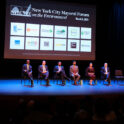
The New York League of Conservation Voters Education Fund (NYLCVEF) hosted an environmental forum at NYU Skirball on Thursday, March 6, with New York City mayoral candidates: former NYS Assemblymember and DNC Vice Chair Michael Blake, NYC Comptroller Brad Lander, Assemblymember Zohran Mamdani, State Senator Zellnor Myrie, State Senator Jessica Ramos, and former NYC Comptroller Scott Stringer. The candidates discussed topics ranging from decarbonizing our buildings and transportation sectors, parks and open space, zero waste, public health, and more.
Watch the full program here.
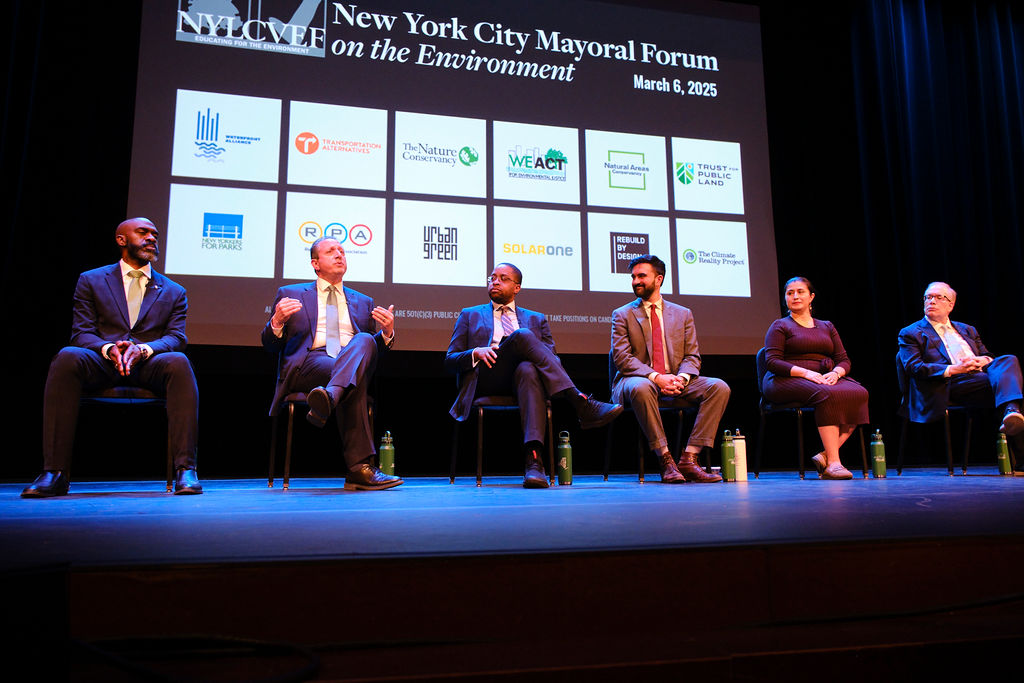
NYLCVEF was proud to present this platform for the candidates to discuss some of the important issues of the day including what NYC's next mayor can do to address the existential crisis of our time, climate change, and we all learned a lot about their positions.
The program began when NYU Chief Sustainability Officer Cecil Scheib delivered opening remarks and welcoming the approximate 600-person audience to the university's flagship theater. Scheib, along with NYLCVEF President Julie Tighe, set the tone for the evening.
"As we all know, in NYC, the primary is often the election of consequence, which is why I encourage everyone here not only to vote, but to vote early in the Primary," said Tighe. "While the federal government may be the proverbial elephant in the room, it is the decisions and policies of the mayor that determine so much of our every day lives."
Tighe also noted that what happens in New York reverberates beyond the state's borders.
"Whether that’s funding parks, being the first in the nation to implement congestion pricing, curbside composting, making our buildings more efficient, or making our coastlines more resilient. WWhen New York acts, other cities across the country - and the globe - follow," when said.
The forum's moderator was Samantha Liebman, Transit Reporter for NY1, and with six candidates and a lot of ground to cover -- few if any could of kept the candidates engaged and on track like she did.
Each year the New York League of Conservation Voters Education Fund works with partners to host nonpartisan candidate forums across the state, allowing for voters to hear directly from candidates about their positions on environmental issues.
The 2025 NYC Mayoral Forum on the Environment was co-sponsored* by Regional Plan Association, WE ACT for Environmental Justice, New Yorkers for Parks, Urban Green Council, Rebuild by Design, The Nature Conservancy, Waterfront Alliance, Transportation Alternatives, Solar One, Trust for Public Land, The Climate Reality Project, and Natural Areas Conservancy.
[TAKE OUR PLEDGE TO VOTE SO WE CAN SHOW EVERYONE THE STRENGTH OF THE ENVIRONMENTAL VOTER IN 2025!]
In what were the last words of the evening, Tighe implored audience members to vote: "Tell your friends how to get informed about where the candidates are on the environment! Be sure to vote! Take our pledge to vote early! You can scan the QR code behind me to do that. Remember, the primary will be held on June 24 with early voting running from June 13 through June 22."
*All organizations listed as co-sponsors are 501(c)(3) public charities that cannot and do not take positions on candidates or political parties.
On Monday, February 17, 2025, the New York League of Conservation Voters Education Fund (NYLCVEF) hosted an insightful session at the New York Association of Towns Annual Meeting & Training School. Held at the New York Marriott Marquis, the event brought together municipal leaders and climate experts from around the state to discuss how towns can take meaningful climate action while also benefiting financially.
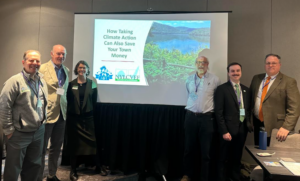
The session, titled "How Taking Climate Action Can Also Save Your Town Money," took place from 4:00 p.m. to 5:00 p.m. in the Alvin/Carnegie Room on the 5th floor. Moderated by Joshua Klainberg, Senior Vice President of NYLCV, the discussion focused on the Climate Smart Communities (CSC) program, a state initiative designed to support local governments in reducing greenhouse gas emissions and preparing for the impacts of climate change. Dazzle Ekblad from the Office of Climate Change at the NYS Department of Environmental Conservation explained the benefits for town participation in the CSC program. The panel featured a diverse group representing CSC certified towns: Warren Lucas, Supervisor of North Salem (Bronze); Christopher Kennan, Supervisor of North East (Bronze); Bruce Shenker, Climate Smart Communities Coordinator for New Lebanon (Silver). NYLCV Federal Policy Manager at Matt Salton rounded out the panel discussing the benefits available to towns through the federal Inflation Reduction Act.
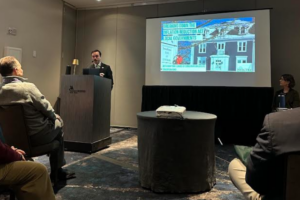
Throughout the discussion, panelists emphasized the significant funding opportunities available to municipalities through state and federal grants, rebates, and new incentives introduced under the Inflation Reduction Act. Town leaders shared real life examples of how their communities have successfully transitioned to cleaner energy and upgraded infrastructure while taking advantage of financial programs designed to make sustainability initiatives more affordable. Supervisors from North Salem and North East highlighted their own experiences with implementing climate-smart strategies, demonstrating how these efforts not only reduce environmental impact but also lead to substantial cost savings and improved community resilience.
The session outlined practical steps for becoming certified as a Climate Smart Community, including strategies for emissions reduction and climate adaptation. Attendees left with a clearer understanding of how to access the financial tools necessary to support sustainability goals while maintaining fiscal responsibility.
Stay tuned for more updates on how local governments are leading the way in climate action.

We believe, at the New York League of Conservation Voters Education Fund, that there’s beauty in the act of voting. Beauty in taking part in our democratic process, beauty in going to the polls and exercising our constitutional right to vote.
And there’s beauty in our messaging, too. This year, we have partnered with Project Your Vote from visual artists Packard Jennings and Jessica Tully on a video message urging everyone to vote. The message was projected Friday evening for several hours on the Brooklyn Public Library’s facade facing Grand Army Plaza, for commuters and all to see. Photographer Randi Rosenblum documented the evening and ABC 7 was on hand to cover the event
[caption id="attachment_6681" align="aligncenter" width="895"]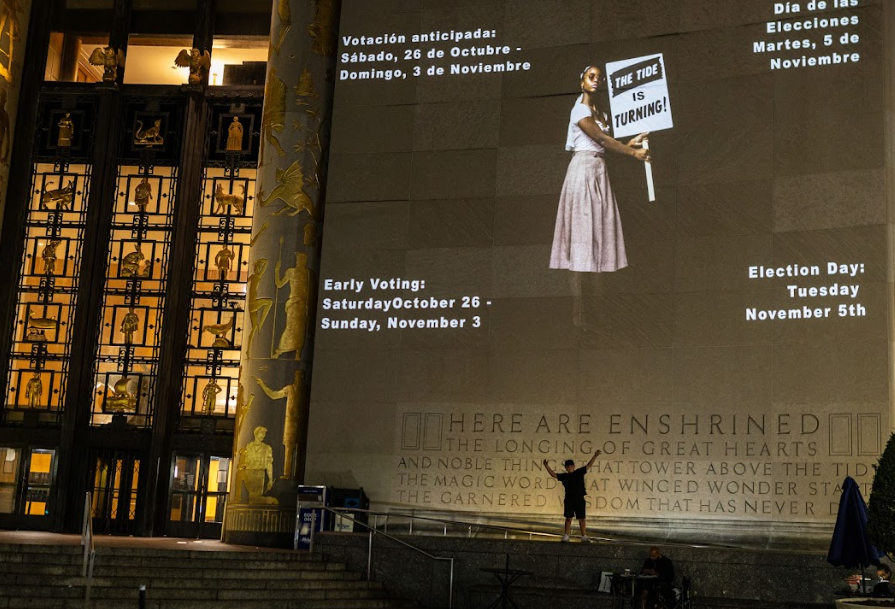 Photo Credit: Randi Rosenblum[/caption]
Photo Credit: Randi Rosenblum[/caption]
The Center for Artistic Activism and The People for the American Way also partnered on this project.
The huge display showed videos of evocative models dressed in vintage clothing holding signs like Your Vote Matters!, Be a Voter!, Our Vote is Our Power!, flashing across the library’s iconic 1941 facade, as a DJ spinned music for the crowd. People stopped to look. People stopped to listen.
NYLCVEF staffers engaged with passersby, chatting, encouraging them to exercise their constitutional right. It was a festive atmosphere surrounding an essential subject.
The key for the NYLCVEF is that every eligible voter should exercise their right to vote.
The League has also partnered with roving video projectionist, Courtney Fallon, to carry this wonderful message north of the city, with stops in Syracuse, Rochester, Buffalo and the Hudson Valley.
Early voting has begun in New York State. It started on Saturday, October 26, and runs through Sunday, November 3, two days before Election Day, Tuesday, November 5.
In New York City, early voting hours on weekend days are 8 am to 5 pm. Early voting hours during weekdays are 8 am to 8 pm.
Early voting hours vary outside New York City. To search for info about your county, it is a two-click process. Go to the New York State Board of Elections website. Once you click on a county on the left side, you will arrive at a chart for that county. Then, you will need to click on the county’s web address to find 2024 election info for that specific county. You can also call your local county election board if you have questions.
On Election Day, the polls are open 6 am to 9 pm statewide.
Depending on where you live, locations for early voting and voting on Election Day may be different.
Wishing everyone a good day at the polls.
Peter Aronson, a volunteer writer at the New York League of Conservation Voters since September 2022, is a former journalist and retired attorney. He is the author of Mandalay Hawk’s Dilemma: The United States of Anthropocene, a novel for middle-grade readers about kids fighting global warming. Kirkus Reviews, in a starred review, wrote: “A scathing work and an essential blueprint for youth battling climate change.” To read more about Peter, visit his website www.peteraronsonbooks.com or to purchase his book, click here.

By Peter Aronson
Climate change is causing anxiety and fear in an increasing number of children and youth around the world. Publications such as Nature, Education Week and Harvard Medicine have written about it and the National Institute of Health has reported on the findings.
“I feel like generally there’s a lot of hopelessness among people my age,” said Croix Hill, a 16-year-old junior at Benjamin Franklin High School in New Orleans, as reported in Education Week. “When talking about [climate change], people are just kind of like, ‘Well, whatever. We’re not even gonna have a planet in 50 years, so it doesn’t even matter.’ ”
In 2021, The Lancet issued a widely-reported survey of 10,000 youth and young people aged 16-25 in 10 countries around the world, including the United States. The study reported that 59 percent of the respondents reported being “very or extremely worried” about climate change and 84 percent were at least “moderately worried.” As reported, more than 50 percent of the respondents said they experienced each of the following emotions: sad, anxious, powerless, helpless and guilty.
And, of course, as we all know, since 2021, climate change has gotten worse, as the world has gotten hotter (2024 is projected to be the hottest year on record, breaking the record set in 2023) and climate disasters are increasing in number and intensity.
The Washington Post reported in 2021 that today’s kids are likely to live through three times as many climate disasters as their grandparents.
And the age group most impacted by global warming are those under 20, which make up the largest segment of the world population, a third of earth’s 8.1 billion inhabitants.
If you are a parent of a young child or a teen, you may have heard about these feelings of anxiety, fear, and helplessness at the dinner table.
For children and youth, there are an increasing number of ways to get involved. While more and more schools are addressing global warming in the classroom, not enough is being done, according to the Columbia University Climate School (CUCS).
“Progress is being made in some states, but on the whole students are not learning enough about climate science quickly enough to give them the knowledge and tools they will need to cope with the impacts of climate change,” according to a CUCS article by Renee Cho.
But there are many opportunities out there for children and youth to engage with fighting climate change in a great variety of ways. It can be as simple as sitting down with teachers, parents and/or friends and deciding, collectively, to make certain changes in their lives to cut their carbon footprints.
This can be done within a family, a friend group, a neighborhood, a class, a grade, a school. It can be done ad hoc, or formally through an organization.
The Climate Initiative, a non-partisan organization, offers opportunities for young people to engage and lead. “We aim to educate, empower and activate youth,” its website states, with a goal of signing up one million youth by 2025. To explore becoming a local climate change ambassador, open to high school and college students and adults, go here.
To learn more about what the UN is doing, read about Youth in Action. The UN reports on important environmental progress from youth movements and offers these nine tips for getting involved:
- Join the United Nations’ ActNow campaign for climate action and sustainability.
- Calculate your carbon footprint. There are many websites offering this calculation for free. Here’s one: carbonfootprint.com.
- Learn from your peers on Facebook’s Reach Not Preach platform.
- Educate yourself on the impact of climate change through an online course offered by UNICEF.
- Play Mission 1.5 and cast your vote for climate action.
- Be a Climate Superhero!
- Read the Global Youth Statement on Climate Change and COP26 Outcomes.
- Join Youngo, a global network of children, youth activists, and youth NGOs on climate change.
- Speak up! Share all this information through social media
An organization called Kids Fight Climate Change is offering youth many opportunities to get involved. It’s a nonprofit dedicated to teaching youth about the climate crisis. Billed as an organization “Made by Youth. Built for Youth,” children and teens can go to their website and sign up to become climate writers, editors, leaders, influencers, designers or volunteers.
“We’re always looking for more voices to uplift in the climate movement,” the website states. “There are many ways to get involved in Kids Fight Climate Change; whether you're just entering the movement or an experienced activist, there’s a place for you here.”
The American Museum for Natural History has a website for younger children. The website offers educational options and on its homepage a museum geologist, Ed Mathez, answers the following question from a sixth grader: What are the most important things kids can do to prevent global warming?
Mathez’s answer, told in greater detail on the museum’s website: Conserve energy, convince people around you to do the same, and keep learning about the subject.
The United Nations Development Programme writes about the importance of the climate youth movement in this article.
The World Economic Forum (WEF) reports on how youth climate activists are on the forefront of forcing change.
“Youth understand that climate change is not only an environmental crisis but also a social justice issue,” the WEF writes. “By prioritizing climate justice, inclusive education, mental health support and global collaboration, they are shaping a movement that addresses systemic inequalities and empowers future generations to create a sustainable and equitable world.”
Or, they can always start with simple tasks that will reduce their carbon footprint.
Here are some simple suggestions: Turn off the lights when not needed. Turn down the heat in winter and the AC in summer. Walk or bike to school. Start a home or community vegetable garden. Make sure your family (and friends and neighbors) are composting and recycling. Stop using plastic and encourage others to do the same. Buy used, not new, clothing. And after you’ve done all this, speak up and let everyone know they need to do the same.
As a parent or an educator, you can work with youth on these tasks, as an intro to fighting climate change. If they want to do more, there is an abundance of resources to get them involved.
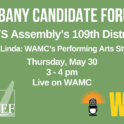
For the first time, the candidates will appear together on the same stage as they vie to fill Assemblymember Pat Fahy’s seat
The forum will be broadcast live on WAMC from 3-4 p.m.
The New York League of Conservation Voters Education Fund and WAMC/Northeast Public Radio are teaming up to host an Environmental Candidate Forum for New York’s 109th Assembly District on May 30, at The Linda, WAMC’s Performing Arts Studio, in Albany, New York.
Invitations have been extended to all candidates appearing on the ballot, with the following candidates confirmed so far:
Owusu Anane
Ginnie Farrell
Andrew Joyce
Alicia Purdy
Dustin Reidy
Gabriella Romero
The seat has been held by Patricia Fahy since 2013. Fahy – who is running for the New York Senate seat being vacated by the retiring Neil Breslin – has been an outspoken advocate for policies to protect New York’s environment and help the state meet its CLCPA goals and transition to a clean energy economy. Whichever candidate assumes her role in AD-109 will have big shoes to fill.
With WAMC’s Ian Pickus moderating, NYLCVEF President Julie Tighe and WAMC reporter Lucas Willard will be asking candidates questions that get at the heart of New Yorkers’ environmental concerns.
“We are proud to once again partner with the League to offer this forum, a service to listeners and voters in the district alike,” said WAMC’s Interim CEO Stacey Rosenberry.
“The most important thing we can do for the environment is vote, and it is absolutely critical that New Yorkers have the opportunity to hear directly from candidates so they can make informed decisions when they go to the polls, said Julie Tighe, President of the New York League of Conservation Voters Education Fund. “The League has a long history of hosting non-partisan candidate forums and we’re excited to partner with WAMC to bring together these candidates running for the 109th Assembly District.”
Event details
Location: The Linda, WAMC's Performing Arts Studio, Albany, New York
Date: May 30, 2024
Entry Time: Doors open at 2:15 p.m. Attendees should arrive by 2:30 p.m. to ensure entry.
Broadcast Time: 3-4 p.m.
*Doors close for the live broadcast at 2:57 pm and no entry will be permitted after that point.
RSVP here: https://actions.nylcv.org/a/candidate-forum-ad-109
About the New York League of Conservation Voters Education Fund
The New York League of Conservation Voters Education Fund (NYLCVEF) educates, engages and empowers New Yorkers to be effective advocates on behalf of the environment — from clean energy and funding for parks, to solid waste and green buildings. For more information, visit www.nylcvef.org.
WAMC/Northeast Public Radio is a regional public radio network serving parts of seven northeastern states including New York, Massachusetts, Connecticut, Vermont, New Jersey, New Hampshire and Pennsylvania. Stations and translators are in 29 locations throughout the region. WAMC/Northeast Public Radio is a member of National Public Radio and an affiliate of Public Radio International.
By Peter Aronson
With almost weekly weather events demonstrating that climate change is impacting our lives in a dangerous and sometimes life-threatening way, the New York League of Conservation Voters (NYLCV) is calling on our elected officials and everyday citizens to take action to cut greenhouse gasses.
On September 29, more rain fell in three hours in parts of New York City than normally falls in a month. Streets, cars and the city’s subway system were inundated by flooding. It was the rainiest September in the city since 1882 and it was a stark reminder that climate change is no longer a distant threat but a present-day reality.
“This is the result of climate change,”said Rohit Aggarwala, commissioner of the NYC Department of Environmental Protection. “Our climate is changing faster than our infrastructure can respond.” (The Independent, Reuters, The New York Times) .
This summer was earth’s hottest since humans began keeping records in 1880. With a hotter planet, more moisture is held in the atmosphere, leading to more, and more intense, rainfall over a short period. This can overwhelm drainage systems, causing flash floods, like the ones we witnessed in New York City. Climate change amplifies the water cycle, making extreme precipitation events more frequent and severe.
The seemingly never ending series of wake-up calls are becoming more frequent and more dangerous. Take just the last several months.
In June, much of the region was blanketed by unhealthy smoke from the historic Canadian wildfires, fueled in part by a heating planet. In July came the historic floods in Vermont and Hudson Valley, NY. Then in August, Lahaina, on the island of Maui, HI, experienced the fifth deadliest wildfire in US history.
Rising temperatures dry out forests, making them more susceptible to wildfires, and these fires release vast amounts of CO2 and particulate matter into the atmosphere, creating the smog that engulfed our region.
We are in the midst of a full blown climate emergency. Our elected officials need to enact policies that will reduce our greenhouse gas emissions, transition the state to clean energy sources, and protect our natural environment if we are going to mitigate the worst impacts and ultimately stem the tide of climate change.
And we need all individuals to adopt daily sustainable habits, such as recycling; composting; buying local; avoiding plastic containers; walking, biking or using public transportation when feasible. For a more complete list of sustainable habits, click here. We also encourage everyone to take action by writing to your elected officials to remind them, repeatedly if necessary, that reducing our greenhouse gas emissions is essential for our city, country and world.
We must all work together to solve this problem. There is no time to waste.
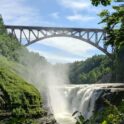
If you are thinking of going somewhere warm for spring break, here are a few green steps you can take to keep your house safe while limiting the amount of energy being used in your vacant home.
While many of these suggestions are for people living in a house, some apply to apartment dwellers as well.
- First thing, consult with your plumber and/or electrician about the lowest temperature you can set your thermostat to while you are away without a danger of freezing pipes. Temperatures may vary depending on the size of your home and how well your home is insulated.
- Discuss with your plumber whether you should or should not turn off the water and the hot water heater.
- If you are concerned about break-ins and want to leave a light or two on, buy the most energy efficient light timers and set it so a light or lights are on only when you think it’s necessary.
- Consult with your electrician about the most energy-efficient light bulbs.
- Before leaving your home, make sure all windows are firmly closed.
- Remember, heat rises, so you may be able to set your thermostat upstairs on lower temps than downstairs.
- Be sure to leave all bedroom and bathroom doors open so that warm air in the house circulates. Leave cabinet doors open if pipes are hidden away in those walls.
- Unplug all electronic devices that use electricity passively, like clocks, cable TV boxes and chargers.
- If your fridge needs a cleaning, clean it just before going away and leave it empty and unplugged while away.
Also, we’re learning that thinking about the above steps can have a lasting impact, making us all more conscious of conserving energy even when we are not on vacation.
Remember, the less energy we use, the smaller carbon footprint we are leaving. Safe travels!

This may not be common knowledge to people living in New York City and the surrounding counties, but the Upper Delaware River Watershed is crucial to the millions residing and working in this area. The watershed region, located in the Catskills and the contiguous southern part of the state, supplies more than 50 percent of the daily water supply for those areas.
In 2022, for the first time, the watershed, which encompasses 2,390 square miles in New York State (primarily Delaware and Sullivan Counties), was awarded $300,000 in funding through the state’s Environmental Protection Fund (EPF), for conservation and watershed protection.
NYLCV wants the 2022 EPF funding to become permanent as an annual line item in the state’s budget.
The watershed area, historically, had pollution problems. Recently, however, the water is cleaner, but there are still threats, including: accelerated erosion, sedimentation of local streams, development pressures, climate change, invasive species and flooding.
Protecting the region and our drinking water is an absolute necessity. The NYLCV has joined forces with the Friends of the Upper Delaware River and the Orange County Land Trust, calling on New Yorkers to sign a petition at Greenactions.org urging Gov. Hochul to maintain this funding for the EPF.
The Upper Delaware River Watershed sits at the northern portion of the Delaware River, as it flows south 330 miles from New York to the Pennsylvania-New Jersey border, and into Delaware before emptying into the Atlantic Ocean. The river is home to more than 45 fish species and supports bird and mammal species, including the bobcat, coyote, and our national bird, the bald eagle. Spanning 200 miles along the border of NJ and PA is the Delaware Water Gap National Recreation Area, home to valuable hemlock tree ravines as well as nearly 200 lakes and ponds. The river provides drinking water for 17 million people in five states. American Rivers named it River of the Year in 2020.
The Delaware River and its tributary rivers and streams travel 4,062 miles in New York State. They feed into 188 different freshwater lakes, ponds and reservoirs, covering 24,932 acres.
For technical data about the watershed, visit the NYS Department of Environmental Conservation website.
The river and its watershed provide tremendous economic, recreational, and ecological value to New York state. Recreational activities attract more than 5.5 million visitors to the region every year, and for good reason. The Delaware River features 73 miles of scenic and recreational parks in New York, as well as one of the finest cold water wild trout fisheries in the country. The value of natural goods and services provided by the Delaware River’s ecosystems in New York State is $3.5 billion, illustrating how crucial the area is to the State’s economy.
The fact that the Delaware River flows south from New York into our three neighboring southern states makes it even more important that New York protect its portion of the river.
A little over 50 years ago, the river was heavily polluted and filled with sewage, uninhabitable for marine life and negatively impacted local communities. Fast forward to today, the Delaware River is much healthier due to monetary support and recognition at the federal level, and because of the broad coordination of restoration efforts by various state agencies, academic institutions, and advocacy groups. The NYLCV is part of this group to make sure a focus remains on the region, so the water and the entire region is protected for generations to come.
Peter Aronson, a volunteer writer at the New York League of Conservation Voters since September 2022, is a former journalist and retired attorney. He is the author of Mandalay Hawk’s Dilemma: The United States of Anthropocene, a novel for middle-grade readers about kids fighting global warming. Kirkus Reviews, in a starred review, wrote: “A scathing work and an essential blueprint for youth battling climate change.” To read more about Peter, visit his website www.peteraronsonbooks.com or to purchase his book, click here.
From the Citizen’s Toolkit
Temperatures are finally starting to drop, and we’re welcoming the crisp autumn air. One of the best ways to fully appreciate and experience the beauty of it is to spend time in one of New York State’s parks. Boasting some of the most beautiful nature in America, New York is home to over 200 state…
With travel, gift giving, and many big meals, the winter holidays are one of the times of the year with the highest rates of personal consumption. Because of this heightened consumption rate, the holidays are the time when being conscious of sustainable practices will have the greatest total impact. Here are some holiday practices you can take to generate an impact, and others that can help foster a sense of love and consciousness toward the environment.
Are you planning on starting 2018 off with the ever-popular goal of working out more often? If so, we have some tips to help you burn calories while staying environmentally friendly. Working out offers countless benefits to the mind and body, but if you’re not careful, it can cause a detriment to your ecological footprint….
On Tuesday, November 8th, voters on the East End of Long Island had an important environmental decision to make on their ballots: whether or not to extend the Community Preservation Fund (CPF) in the five East End towns.
Each year, NYLCV and the NYLCV Education Fund work closely with New York’s leading environmental, public health, conservation, energy, environmental justice, and transportation organizations to identify the state’s most pressing priorities on fighting climate change, conserving land and water, and protecting public health. The result of that effort is our 2017 New York State legislative…
Water issues might not be making as many headlines anymore, but even if your local supply hasn’t made it to the news, you might remain at risk without knowing it. Given the number of contaminants that can make their way into shared or even private wells, you’ll need to make sure your drinking water stays…
The summer heat means more sweat, and by extension more loads of laundry to do. However there a variety of practices other than re-wearing your sweaty gym clothes that can make your laundry practices more sustainable. Wash with Cold Water Studies show that 75% of the total energy-use and carbon emissions associated with your laundry…
Eating locally is easy in the summer, when farm stands seem to be overflowing with fresh fruits, veggies, and leafy greens, so now is the best time to build a seasonal eating habit. Here are some more tips to help you green your diet:
The New York League of Conservation Voters Education Fund is pleased to present this 2017 Green Guide as a resource for all candidates running for public office in New York City. This document, released at our Environmental Candidate School, is a one-stop-shop for candidates to learn about new opportunities and approaches to persistent sustainability problems….
Temperatures are finally starting to drop, and we’re welcoming the crisp autumn air. One of the best ways to fully appreciate and experience the beauty of it is to spend time in one of New York State’s parks. Boasting some of the most beautiful nature in America, New York is home to over 200 state…
With travel, gift giving, and many big meals, the winter holidays are one of the times of the year with the highest rates of personal consumption. Because of this heightened consumption rate, the holidays are the time when being conscious of sustainable practices will have the greatest total impact. Here are some holiday practices you can take to generate an impact, and others that can help foster a sense of love and consciousness toward the environment.
Are you planning on starting 2018 off with the ever-popular goal of working out more often? If so, we have some tips to help you burn calories while staying environmentally friendly. Working out offers countless benefits to the mind and body, but if you’re not careful, it can cause a detriment to your ecological footprint….
On Tuesday, November 8th, voters on the East End of Long Island had an important environmental decision to make on their ballots: whether or not to extend the Community Preservation Fund (CPF) in the five East End towns.
Each year, NYLCV and the NYLCV Education Fund work closely with New York’s leading environmental, public health, conservation, energy, environmental justice, and transportation organizations to identify the state’s most pressing priorities on fighting climate change, conserving land and water, and protecting public health. The result of that effort is our 2017 New York State legislative…
Water issues might not be making as many headlines anymore, but even if your local supply hasn’t made it to the news, you might remain at risk without knowing it. Given the number of contaminants that can make their way into shared or even private wells, you’ll need to make sure your drinking water stays…









